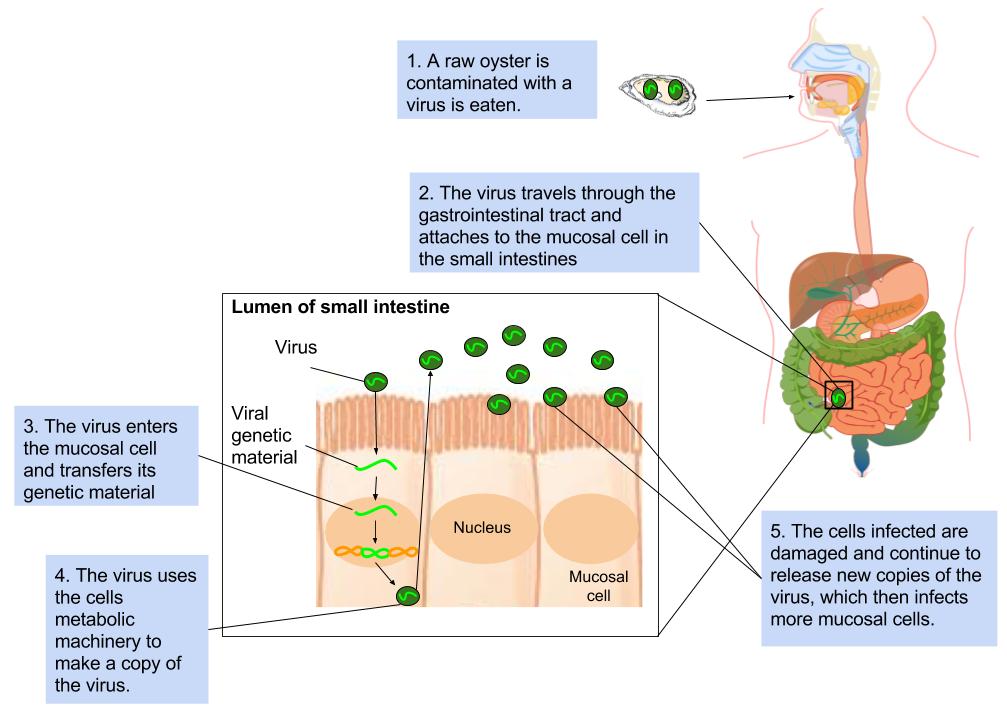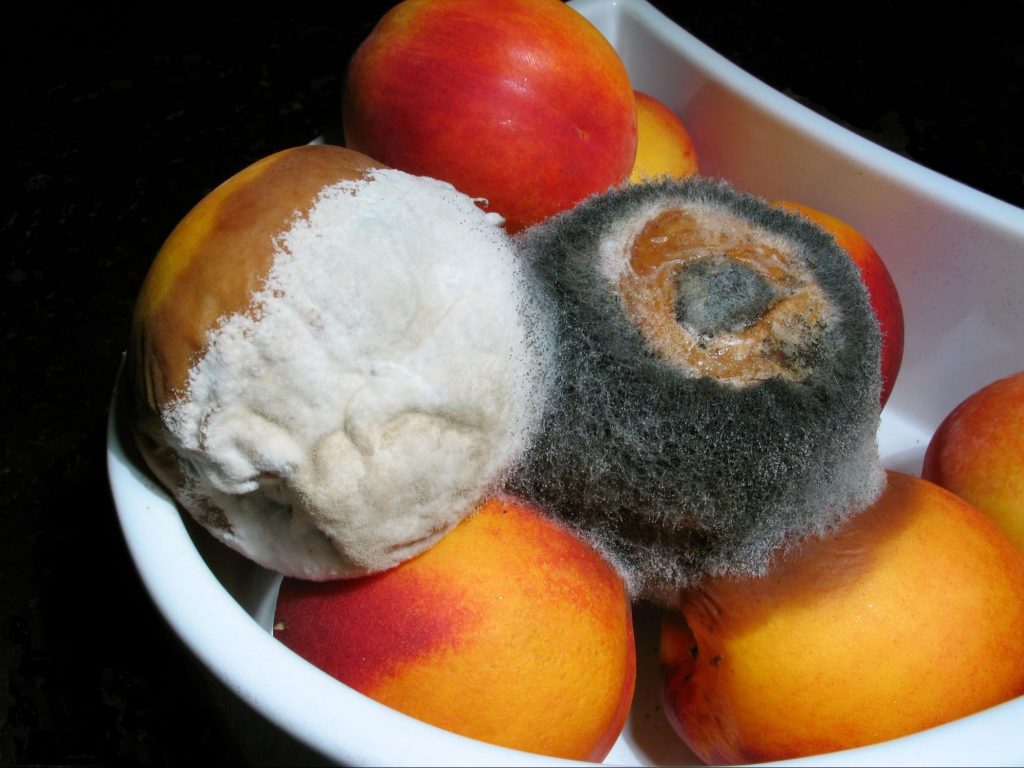1.4.3. Causes of Foodborne Illness
Foodborne Illness and Food Safety
Foodborne illness is a serious threat to health. Sometimes called “food poisoning,” foodborne illness is a common public health problem that can result from exposure to a pathogen or a toxin via food or beverages. Raw foods, such as seafood, produce, and meats, can all be contaminated during harvest (or slaughter for meats), processing, packaging, or during distribution, though meat and poultry are the most common source of foodborne illness. For all kinds of food, contamination also can occur during preparation and cooking in a home kitchen or in a restaurant. For example, in 2009 the Marshall Islands reported 174 cases presenting with vomiting and diarrhea. After an epidemiological investigation was completed, they identified the cause to be egg sandwiches that had been left at room temperature too long resulting in the growth of foodborne toxins in the egg sandwiches.[1]
In many developing nations, contaminated water is also a major source of foodborne illness. Many people are affected by foodborne illness each year, making food safety a very important issue. Annually, one out of six Americans becomes sick after consuming contaminated foods or beverages.[2] Foodborne illness can range from mild stomach upset to severe symptoms, or even fatalities. The problem of food contamination can not only be dangerous to your health, it can also be harmful to your wallet. Medical costs and lost wages due to salmonellosis, just one foodborne disease, are estimated at over $1 billion per year.
At-Risk Groups
No one is immune from consuming contaminated food but, whether you become seriously ill depends on the microorganism, the amount you have consumed, and your overall health. In addition, some groups have a higher risk than others for developing severe complications to foodborne disease. Who is most at risk? Young children, elderly people, and pregnant women all have a higher chance of becoming very sick after consuming contaminated food. Other high-risk groups include people with compromised immune systems due to HIV/AIDS, immunosuppressive medications (such as after an organ transplant), and long-term steroid use for asthma or arthritis. Exposure to contaminated food could also pose problems for diabetics, cancer patients, people who have liver disease, and people who have stomach problems as a result of low stomach acid or previous stomach surgery. People in all of these groups should handle food carefully, make sure that what they eat has been cooked thoroughly, and avoid taking any chances that could lead to exposure.
The Major Types of Food Borne Illness
Foodborne illnesses are either infectious or toxic in nature. The difference depends on the agent that causes the condition. Microbes, such as bacteria, cause food infections, while toxins, such as the kind produced by molds, cause intoxications. Different diseases manifest in different ways, so signs and symptoms can vary with the source of contamination. However the illness occurs, the microbe or toxin enters the body through the gastrointestinal tract, and as a result common symptoms include diarrhea, nausea, and abdominal pain. Additional symptoms may include vomiting, dehydration, lightheadedness, and rapid heartbeat. More severe complications can include a high fever, diarrhea that lasts more than three days, prolonged vomiting, bloody stools, and signs of shock.
One of the biggest misconceptions about foodborne illness is that it is always triggered by the last meal that a person ate. However, it may take several days or more before the onset of symptoms. If you develop a foodborne illness, you should rest and drink plenty of fluids. Avoid anti-diarrheal/-vomiting medications, because they could slow the elimination of the contaminant.
The Reproduction of Microorganisms
The conditions under which microorganisms reproduce within food are as follows:
- temperature: Between 40°F and 140°F (4°C-60°C), which is called the danger zone, bacteria grow rapidly.
- time: More than two hours in the danger zone.
- water: High moisture content is helpful. Fresh fruits and vegetables have the highest moisture content.
- oxygen: Most microorganisms need oxygen to grow and multiply, but a few are anaerobic and do not.
- acidity and pH level: Foods that have a low level of acidity (or a high pH level) provide an ideal environment, since most microorganisms grow best around pH 7.0 and not many will grow below pH 4.0 . Examples of higher pH foods include egg, meat, seafood, milk, and corn. Examples of low pH foods include citrus fruits, sauerkraut, tomatoes, and pineapples.
- nutrient content: Microorganisms need protein, starch, sugars, fats, and other compounds to grow. Typically high-protein foods are better for bacterial growth.
Bacteria
All foods naturally contain small amounts of bacteria. However, poor handling and preparation of food, along with improper cooking or storage can multiply bacteria and cause illness. In addition, bacteria can multiply quickly when cooked food is left out at room temperature for more than a few hours. Most bacteria grow undetected because they do not change the color or texture of food or produce a bad odor. Freezing and refrigeration slow or stop the growth of bacteria, but does not destroy the bacteria completely. The microbes can reactivate when the food is taken out and thawed.

Viruses, Parasites, and Toxins
Hepatitis A is an example of one of the more well-known food-contaminating viruses. Sources include raw shellfish from polluted water, and food handled by an infected person. This virus can go undetected for weeks and, on average, symptoms do not appear until about one month after exposure. At first, symptoms include malaise, loss of appetite, nausea, vomiting, and fever. Three to ten days later, additional symptoms can manifest, including jaundice and darkened urine. Severe cases of a hepatitis A can result in liver damage and death.
The most common form of contamination from handled foods is the norovirus.
Parasitic protozoa are microscopic organisms that may be spread in food and water. They include microscopic worms from (example) raw fish, and other parasites from water, meats, fruits and vegetables.
Toxins from moulds, visible or invisible in grains and nuts, also apples, celery, and other produce can cause allergic reactions, respiratory problems, intestinal illnesses, liver failure, liver cancer, and in some cases death.
Figure 1.4.3.1 Viruses in the Human Body

Figure 1.4.3.2 Mouldy Nectarines

Pesticides
Pesticides are important in food production to control diseases, insects, and other pests. They protect crops and ensure a large yield. However, synthetic pesticides can leave behind residues, particularly on produce, that can be harmful to human health. Foods that contain the highest levels of pesticide residue include conventionally-grown peaches, apples, bell peppers, celery, nectarines, strawberries, cherries, pears, spinach, lettuce, and potatoes. (In general these are foods which have skins that we eat). Foods that contain the lowest levels of pesticide residue include avocados, pineapples, bananas, mangoes, asparagus, cabbage, and broccoli.[3] (In general these are foods which have skins that we do not eat). In many cases, the amount of pesticide exposure is too small to pose a risk. However, harmful exposures can lead to certain health problems and complications, including cancer. Also, infants and young children are more susceptible to the hazards of pesticides than adults. In addition, using synthetic pesticides, herbicides, and fertilizers contributes to soil and water pollution and can be hazardous to farm workers.
To protect the public and their workers, many farmers now rely on alternatives to synthetic pesticide use, including crop rotation, natural pesticides, and planting non food crops nearby to lure pests away. Some consumers choose to reduce their exposure to pesticides by purchasing organic produce. You can protect yourself against pesticides by thoroughly rising all fruits and vegetables that you but. Alternatively, organic foods are grown or produced without synthetic pesticides or fertilizer, and all growers and processors must be certified by government agencies. However, conventionally-grown produce should be fine for fruits and vegetables that appear on the low-residue list.
Pollutants
Pollutants are another kind of chemical contaminant that can make food harmful. Chemical runoff from factories can pollute food products and drinking water. For example, dioxins are chemical compounds created in industrial processes, such as manufacturing and bleaching pulp and paper. Fish that swim in dioxin-polluted waters can contain significant amounts of this pollutant, which causes cancer. When metals contaminate food, it can result in serious and even life-threatening health problems. A common metal contaminant is lead, which can be present in drinking water, soil, and air. Lead exposure most often affects children, who can suffer from physical and mental developmental delays as a result.
Methyl mercury occurs naturally in the environment and is also produced by human activities. Fish can absorb it, and the predatory fish that consume smaller, contaminated fish can have very high levels. This highly toxic chemical can cause mercury poisoning, which leads to developmental problems in children, as well as autoimmune effects. A condition called Minamata disease was identified in 1956 in Japan. It was named for the town of Minamata, which was the site of an environmental disaster when methyl mercury was released into the surface water near a factory. Many residents experienced neurological issues, including numbness in hands and feet, muscle weakness, a narrowing of the field of vision, damage to hearing and speech, and ataxia, which is a lack of muscle coordination.[4]
PCBs, or polychlorinated biphenyls, are man-made organic compounds that consists of carbon, hydrogen and chlorine. Due to their non-flammability, chemically stable, and high boiling points PCBs were manufactured and used commercially from 1929 until 1979 when it was banned. Like methylmercury, higher concentrations of this contaminant are found in predatory fish. Health effects include complications in physical and neurological development in children, and this compound is potentially a carcinogen. PCB contamination also can affect the immune, reproductive, nervous, and endocrine systems.[5]
- Thein CC, Trinidad RM, Pavlin B. A Large Foodborne Outbreak on a Small Pacific Island. Pacific Health Dialogue. 2010, 16(1). pp.75-80. https://www.ncbi.nlm.nih.gov/pubmed/20968238. Accessed January 28, 2018. ↵
- Foodborne Illnesses and Germs. Centers for Disease Control and Prevention.https://www.cdc.gov/foodsafety/foodborne-germs.html . Updated January 23, 2018. Accessed January 28, 2017. ↵
- Pesticide Residues in Food. World Health Organization. http://www.who.int/mediacentre/factsheets/pesticide-residues-food/en/. Updated January 2018. Accessed January 28, 2018. ↵
- Minamata Disease: The History and Measures. Ministry of the Environment, Government of Japan.http://www.env.go.jp/en/chemi/hs/minamata2002/. Published 2002. Accessed December 21, 2011. ↵
- Learn About Polychlorinated Biphenyls. US Environmental Protection Agency. https://www.epa.gov/pcbs/learn-about-polychlorinated-biphenyls-pcbs. Updated August 10, 2017. Accessed January 28, 2018. ↵

